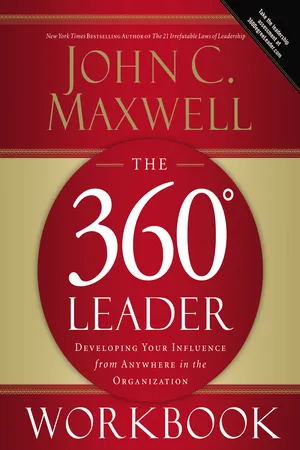
The 360 Degree Leader Workbook
Developing Your Influence from Anywhere in the Organization
- 288 pages
- English
- ePUB (mobile friendly)
- Available on iOS & Android
The 360 Degree Leader Workbook
Developing Your Influence from Anywhere in the Organization
About this book
The 360 Degree Leader Workbook will equip you with the skills you need to begin making a difference in your organization, career, and life, today—with or without the promotion.
Ninety-nine percent of all leadership occurs not from the top but from the middle of an organization. Usually, an organization has only one person who is the leader. So what do you do if you are not that one person?
In The 360 Degree Leader Workbook, Maxwell addresses that very question and takes the discussion even further. You don't have to be the main leader to make a significant impact in your organization. Good leaders are not only capable of leading their followers but are also adept at leading their superiors and their peers.
Debunking myths and shedding light on the challenges, John Maxwell offers specific principles for Leading Down, Leading Up, and Leading Across. 360-Degree Leaders can lead effectively, regardless of their position in an organization. By applying Maxwell's principles from this workbook and accompanying book, you will expand your influence and ultimately be a more valuable team member.
Frequently asked questions
- Essential is ideal for learners and professionals who enjoy exploring a wide range of subjects. Access the Essential Library with 800,000+ trusted titles and best-sellers across business, personal growth, and the humanities. Includes unlimited reading time and Standard Read Aloud voice.
- Complete: Perfect for advanced learners and researchers needing full, unrestricted access. Unlock 1.4M+ books across hundreds of subjects, including academic and specialized titles. The Complete Plan also includes advanced features like Premium Read Aloud and Research Assistant.
Please note we cannot support devices running on iOS 13 and Android 7 or earlier. Learn more about using the app.
Information
SECTION III
THE PRINCIPLES 360-DEGREE LEADERS PRACTICE TO LEAD UP
Lead-Up Principle #1
LEAD YOURSELF EXCEPTIONALLY WELL
WHAT A LEADER MUST SELF-MANAGE
1. MANAGE YOUR EMOTIONS
2. MANAGE YOUR TIME
3. MANAGE YOUR PRIORITIES
80 percent of the time—work where you are strongest15 percent of the time—work where you are learning5 percent of the time—work in other necessary areas
4. MANAGE YOUR ENERGY
Table of contents
- Cover Page
- Title Page
- Copyright Page
- Ebook Instructions
- Contents
- Section I: The Myths of Leading from the Middle of an Organization
- Section II: The Challenges 360-Degree Leaders Face
- Section III: The Principles 360-Degree Leaders Practice to Lead Up
- Section IV: The Principles 360-Degree Leaders Practice to Lead Across
- Section V: The Principles 360-Degree Leaders Practice to Lead Down
- Conclusion
- Notes
- About the Author